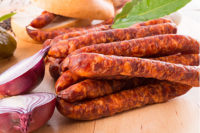More than just mixing






Traditionally, the mixing process has been used to combine meat with other ingredients, or to extract protein to improve moisture and fat binding, as well as texture, upon cooking. Today, mixing is increasingly being combined with processes such as cooking and chilling to improve these processes and the final products. Chilling in a mixer can be an effective process, whether the chilling is applied to cooked meat blends or to raw meat blends that are to be further processed.
Traditionally, kettles were used to cook meat to make products such as chili, taco meat, etc. Daniel Voit of Blentech has talked about this subject at OSU’s Thermal Processing Short Course and he has emphasized that cooking meat products in a horizontal, jacketed mixer (with horizontal agitators) results in more even mixing and less damage to the meat particles during cooking, compared to kettles or mixers with vertical agitators. Meat particles are also more likely to settle out when mixed in a kettle or mixer with vertical agitator, which can result in uneven cooking of meat particles.
Although steam could be injected directly into a mixer for cooking, if browning of the meat is desired, the meat mixtures need to be heated indirectly through the walls of the mixer. Steam is the most common heating medium used in jacketed mixers.
Using dual, intermeshing paddle agitators works best for mixing and cooking very viscous meat products, such as taco meat or chili. When using jacketed mixers to cook meat, Voit recommends spring-loaded scrapers to move the meat mixture away from the hot inner walls of the mixer, to minimize “burn-on” and improve heat transfer. Burn-on is not only a visual defect, but it also reduces the heat transfer efficiency, as an accumulation of burn-on insulates the inner walls of the mixer, slowing the heat transfer rate. Even when high heat transfer efficiency is achieved through proper scraping, effective mixing is also necessary to obtain uniform temperatures throughout the batch. Eliminating cold spots in the mixer allows for lower endpoint temperatures and shorter cooking times to ensure that the entire batch has achieved sufficient lethality.
Burn-on also is minimized by reducing the extracted or soluble protein on the meat particles. This is achieved by keeping the meat at or below 36°F during initial grinding and mixing before the cooking process starts. Burn-on is also reduced by reducing steam pressure, to reduce the temperature of the inner wall of the mixer.
For meat products that are cooked in a horizontal mixer, the most efficient way to chill them is to use the same mixer to chill the product that was used to cook it. There are several methods for chilling cooked meat, including vacuum cooling, jacket cooling and direct injection of cryogens into the meat mixture, or a combination of these methods. There isn’t one method that works for chilling all products, but for chilling cooked products in a mixer, a combination of jacketed cooling and vacuum cooling is often used. Direct injection of cryogens into the mixer may be preferred because of lower initial equipment costs, however, the cryogen costs can be prohibitive for some, when chilling cooked products in a mixer.
Chilling raw meat in a mixer is also beneficial for controlling cold meat temperatures when making meat blends that will be further-processed into sausage, for which particle definition is important, or into formed products, for which meat temperature is important for proper forming. This is especially important for products in which no or minimal water can be added to the product, in the form of ice. Heat generated during the mixing process can damage the fat cells in ground meat, resulting in fatting out of cooked sausage or smearing of the fat under the casing of uncooked sausage. Meat blends can be mixed longer to maximize protein extraction in cooked sausages without concerns of fatting out if the blends are kept cold enough. For ground and mixed products that are to be formed, such as patties, nuggets, etc., meat temperatures are very important for maximizing the uniformity of the formed product shapes and unit weights. In all cases, control of blend temperatures is improved by metering the exact amount of cryogen that is injected into the mixer.
Traditionally, CO2 or liquid nitrogen was injected into the top of the mixer, through the lid. Today, bottom injection of cryogens allows for immediate and complete contact of the cryogens with the meat in the mixer and much less loss of the cryogens to the atmosphere. This results in more rapid chilling of the product in the mixer, while using less cryogen, compared to the top-injection method. Faster mixing to reach the target temperature is better for products such as ground beef, in which longer mixing times can cause problems during the forming process or result in a rubbery cooked texture.
Mixers are no longer used just to combine meat with spices; they are also increasingly used for a variety of cooking and chilling processes. Multiple methods are available for both cooking and chilling in a mixer, and no method is better than the others for all products. The final product characteristics need to be considered when choosing the best method.
Looking for a reprint of this article?
From high-res PDFs to custom plaques, order your copy today!








